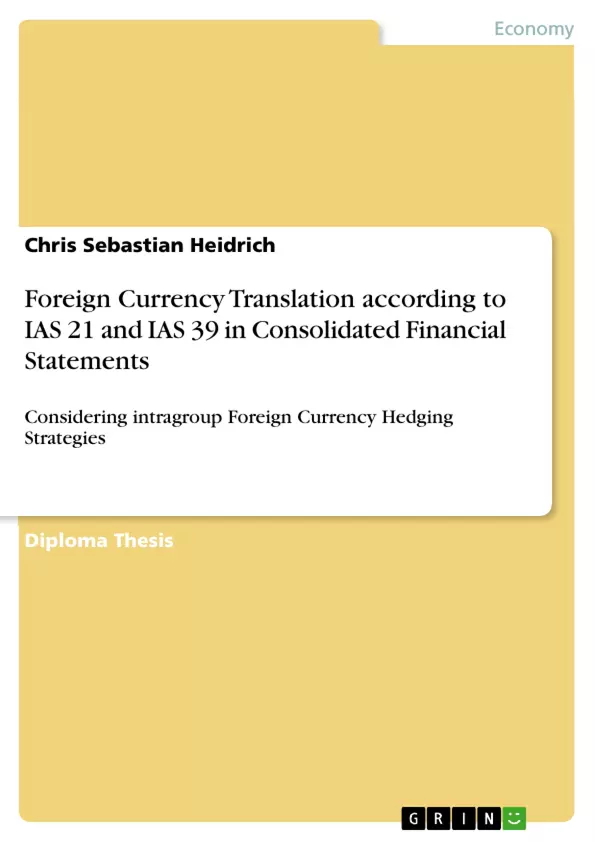This book deals with foreign currency translation under IAS/IFRS considering hedging strategies that help to minimize foreign currency exposures. It is broadly described, which currency exposures companies face, which basic hedging strategies exist and how they are accounted for in consolidated financial statements of international groups.
After the foreign currency exposures are introduced and basic hedging strategies for each of these exposures are provided, the procedure of foreign currency translations according to IAS 21 (revised 2003) is introduced.
The paper deals with the translation of transactions denominated in currencies other than the company’s home currency as well as with the inclusion of foreign subsidiaries in the consolidated financial statements. Therefore, various examples are provided.
As the topic of the thesis is foreign currency hedging, a closer look is taken on IAS 39 (revised 2003) which includes introduction of the three kinds of hedging and their accounting as required by IAS 39. Especially the links between IAS 21 and IAS 39 are pointed out and analyzed. Also the section dealing with IAS 39 provides various examples that make the reader understand the accounting and consolidation procedures.
At the end, exposure drafts of the IASB dealing with IAS 39 are introduced and the possible effects are briefly mentioned.
This paper also includes a case study, based on the example of a big Chilean incorporated Company. This case study provides the problems and possible solutions of foreign currency risks a “real” company faces as well as the related accounting issues. Furthermore, the case study shows, how foreign currency hedges are accounted for using other accounting principles (here Chilean GAAP) and which steps have to be taken to perform a reconciliation from Chilean GAAP to IFRS.
As the thesis has been presented at a German university, all questions and important points are seen from both, a theoretic view and a practical view.
It provides the reader a comprehensive knowledge of currency translation and hedge accounting and makes him able to understand where these two topics are linked and which problems related to this topic companies face when preparing (consolidated) financial statements under IFRS.
Inhaltsverzeichnis (Table of Contents)
- Introduction
- Management of Foreign Currency Risks
- Currency Exposures
- General Remarks
- Translation Exposure
- Transaction Exposure
- Economic Exposure
- Instruments of Foreign Currency Risk Management
- General Remarks
- Managing Translation Exposure
- Managing Transaction Exposure
- Managing Economic Exposure
- Currency Exposures
- Foreign Currency Translation according to IAS 21(revised 2004)
- General Remarks
- The Concept of the Functional Currency
- Background
- Factors determining the Functional Currency
- Translating Foreign Currency Transactions into the Functional Currency
- Monetary Items
- Non-Monetary Items
- Net Investments in Foreign Operations
- Recognition of Exchange Differences
- Accounting for Hedges of a net Investment in a Foreign Operation
- The Presentation Currency
- Allowed Presentation Currencies
- Translation from the Functional Currency into the Presentation Currency
- Translation of Foreign Operations
- Recognition of Exchange Differences
- Exchange Differences in Separate Financials Statements
- Exchange Differences in Consolidated Financial Statements using a Foreign Currency Hedge
- Exchange Differences arising from Intragroup Monetary Items
- Foreign Currency Hedge Accounting according to IAS 39 in multinational groups
- Introducing Hedge Accounting under IFRS
- Overview
- Derivative Financial Instruments
- Hedges for Foreign Currency Risk
- Qualifying Instruments for Hedge Accounting
- Effectiveness Criteria
- Hedging of Net Positions
- Accounting for Fair Value Hedges
- Accounting for Cash Flow Hedges
- Exposure Draft ED-7 "Cash Flow Hedge Accounting of Forecast Intragroup Transactions"
- Planned Amendments of IAS 39(revised 2003)
- Reasons for the planned Amendments of IAS 39
- Review on the proposed Amendments
- Introducing Hedge Accounting under IFRS
- Summaries
Zielsetzung und Themenschwerpunkte (Objectives and Key Themes)
This thesis aims to analyze the accounting for foreign currency translation and hedge accounting within multinational groups, specifically addressing the application of IAS 21 (revised 2004) and IAS 39 in consolidated financial statements. It explores the management of foreign currency risks, the concept of functional currency, and the recognition of exchange differences. The thesis also examines the use of hedge accounting under IFRS and the implications of intragroup foreign currency hedging strategies.
- Foreign currency translation according to IAS 21
- Hedge accounting according to IAS 39
- Management of foreign currency risks
- Intragroup foreign currency hedging strategies
- Impact of accounting standards on consolidated financial statements
Zusammenfassung der Kapitel (Chapter Summaries)
The thesis begins by introducing the management of foreign currency risks, outlining the different types of exposures (translation, transaction, and economic). It then explores the instruments available for managing these risks, including hedging strategies.
Chapter 3 delves into the complexities of foreign currency translation under IAS 21 (revised 2004). It explains the concept of functional currency and the process of translating foreign currency transactions into the functional currency. The chapter also addresses the recognition of exchange differences and the accounting for hedges of net investments in foreign operations.
Chapter 4 focuses on foreign currency hedge accounting according to IAS 39. It introduces the concept of hedge accounting under IFRS and discusses the qualifications for hedge accounting, effectiveness criteria, and accounting for fair value and cash flow hedges.
Chapter 5 provides a summary of the key findings and conclusions of the thesis.
Schlüsselwörter (Keywords)
The main keywords of this thesis include: foreign currency translation, IAS 21, IAS 39, hedge accounting, functional currency, presentation currency, exchange differences, intragroup foreign currency hedging, consolidated financial statements, multinational groups, IFRS.
- Arbeit zitieren
- Chris Sebastian Heidrich (Autor:in), 2004, Foreign Currency Translation according to IAS 21 and IAS 39 in Consolidated Financial Statements, München, GRIN Verlag, https://www.grin.com/document/36137



